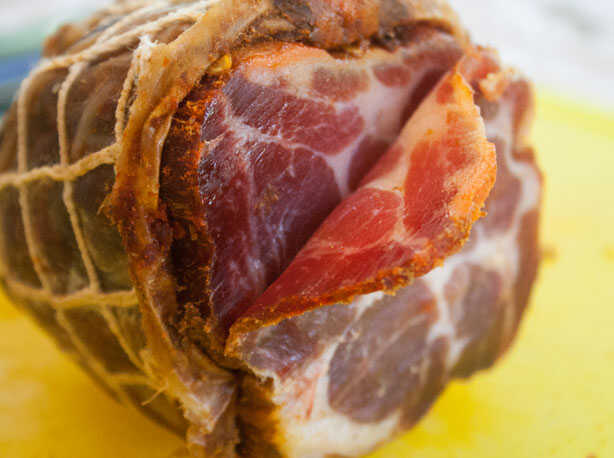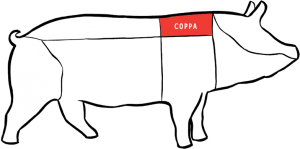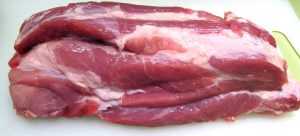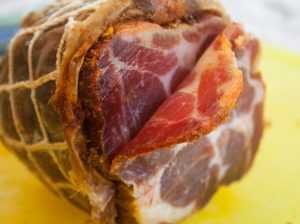
Copa or Coppa is an abbreviation of the Italian Capocollo, which in turn comes from the Latin “caput collum” and means neck, as pork neck meat is traditionally used to make this charcuterie delicacy.
I recommend reading the last recipe, which is the COLLAGEN FILM COPPA.
There are many traditional recipes, but in general they share some steps, which initially involve intense salting of the meat, with or without seasoning. Afterwards, the meat is rinsed, massaged with wine, black pepper and other seasonings, wrapped in beef intestine, tied with string and aged/dried for a long period, which can vary from 2 to 6 months depending on the size of the piece.
Ingredients
- Pork (neck/shoulder) – 2kg;
- salt – 60g;
- Sugar – 30g;
- Curing salt 2 (6% of nitrite, 3% of nitrate and 93.75% of salt) – 5g;
- Black Pepper – 4g;
- Blonde powder – 2g;
- Nutmeg powder – 1g;
- Thyme – 3g;
- Chopped garlic – 2 cloves;
- Red wine – 1 glass;
- Thick natural beef tripe or pork tripe open or collagen casing 80 or collagen film.
Coppa preparation
Mix all the ingredients, except the wine, spread and rub all over the meat, ensuring that the entire surface is covered.
Transfer the meat to a covered plastic container and leave it in the refrigerator for two weeks so that there is a homogeneous distribution of salt, curing and seasoning.
After this period, remove the meat and rinse well under running water to remove any ingredients that are still on the surface of the meat. Dry the meat well and apply the wine by massaging it into the meat, this will help to acidify it, protecting it from microorganisms and giving an additional flavor to the final product.
Wrap the meat in a natural or artificial collagen casing and a string net to make it easier to hang and keep the meat compacted. High caliber beef intestine is more difficult to find, so a tip is to take a smaller intestine, beef or pork, open it by cutting one side and wrap the entire meat using these “strips” of intestine. Then just secure it well and compact it using the string. The important thing is to wrap all the meat in the casing and press it well using string.
Transfer to a maturation chamber and wait between 4 and 8 weeks or until there is a weight reduction between 30% and 40%. The maturation chamber can be a wine cellar or a room/room with air circulation and controlled temperature and humidity. The temperature should be around 14 degrees and the humidity between 70% and 80%.







Hi, I was browsing your blog and found several interesting articles like this one.
When I use collagen casing and penicillium culture in the cup, after maturation do I remove the casing and fungus for consumption or can I consume it with the casing and fungus?
To monitor the weight loss of the piece, would the initial weight that I should consider be before putting it to cure (raw meat) or is the initial weight considered after the curing period?
I made it according to your recipe. I packed it in collagen casing. However, as I don't have a maturation camera and my city is very hot, I'm putting it to mature in the refrigerator. Have a problem?.
Hi Ricardo, what can happen in the refrigerator is the outside of the cup drying out, preventing the water from the center of the meat from migrating outwards. It depends on the humidity your refrigerator maintains internally. Refrigerators are generally very dry. You can try adapting a box like we did in this recipe for refrigerated salami: https://charcutaria.org/receitas/salame-artesanal-feito-na-geladeira/
I made this adaptation with a panel fan and hygrometer inside a box inside the refrigerator. The maximum I'm getting for humility is 67/68 percent. Does this solve it?
You can probably already get a good result. Check that your hygrometer is working well, many of these sensors with digital displays are very inaccurate. Test by placing it in different environments to see if it alternates reading appropriately.
I made the suggested adaptation but I'm only able to reach a humility of 60 to 67 percent. Is it enough?
You can probably already get a good result. Check that your hygrometer is working well, many of these sensors with digital displays are very inaccurate. Test by placing it in different environments to see if it alternates reading appropriately.
Good Afternoon... I have a question: After the sirloin cup has been matured, with a weight loss in the range of 43%, and ready for tasting, can I store it outside the cold environment for how long, as I didn't want to consume it immediately, or what is the procedure so that you do not lose weight quickly.
Paulo, once it's ready, the ideal is to remove it from the casing and rub some olive oil on the outside. Once this is done, you can vacuum wrap it or wrap it in plastic wrap several times and store it in the refrigerator. Outside the refrigerator this way is also possible, but on very hot days the fat may start to release, so in the refrigerator it is safer. It will last for at least 90 days without loss of quality.
Good afternoon, I did the entire procedure 3 days ago, but as my city doesn't have curing salt 2, I did it without it. Is there still time to put it in or can it be done without??..
Would you help me.
Continuation. So I washed it, to get rid of the rancidity, cut it in half and wrapped it in collagen casing, reapplied curing salt and antioxidants and put it in the fridge. After another ten days, it is still very pink, the flesh has not yet darkened. So I threw coarse salt inside the casings, to see if it would speed up the loss of water. Is there still a way or do I throw everything into the woods and start again? 🙂
Hi Tomás. Did you track your weight loss? How much weight did you start with and now, after how many days, how much do you weigh?
Good morning. I'm looking for some guidance, if you can help me. I followed a similar recipe to this one, left it marinating for two weeks and then wrapped it in a paper towel, covered in cayenne pepper and ground cloves. But I didn't leave it at room temperature before putting it in the fridge. After two weeks, seeing that the loss of water was very slow, I decided to take it out of the fridge and hang it in the net, but without using casing, protected by a mosquito net, at a temperature of 10 to 24 degrees. The two and a half kilo piece didn't look very good after about ten days, because the fat oxidized and covered the entire piece.
In this recipe, shouldn't the starter culture be added or is it replaced with vine?
Starter culture matures correctly?
The starter culture is recommended to provide more protection and quality to the canopy, but it is not mandatory. Wine also helps with protection. If you want to use the starter culture, add it immediately after bagging it in the casing and leave the cup hanging for 72 hours at a temperature close to 24ºC. This is the fermentation stage. Maturation comes after fermentation, a stage in which the canopy loses weight and gains more complex aromas and flavors.
Hello, can it mature in the fridge at around 5ºC?
Another question, does baking paper do +- the same function as collagen film? Could it be used?
Hi Marcio, yes it can be done in the fridge, but be careful with the humidity, which cannot be too low. Yes, baking paper can simulate it, but it is not controllable as different brands of paper may have different porosities. Furthermore, baking paper does not adhere to the meat and can create internal spaces that facilitate the proliferation of mold hidden between the paper and the meat. You can do it in the regular refrigerator like this: Handmade salami made in the fridge
Learn and ask questions.
VERY GOOD RECIPE
I would also like the socol recipe
Good afternoon
How do I use liquid smoke in the pantry? I add it first. Or later.
Use it at the beginning so that the smoke is incorporated while the canopy is curing in the refrigerator.
Good afternoon. I hear a lot about eating raw pork causing serious illnesses. How can you tell if a cup or salami is not spoiled?
Good morning: if we use yakult to create angry coating. Should it be sprayed directly on the meat or after being placed in the casing?
Good afternoon, how are you?? If I have a suitable maturation chamber for the entire process, could I hang the cup piece without the casing or baking paper?
Good afternoon, my brother uses baking paper instead of casing, and it gives a good result.
Good afternoon. I would like to know if I can use curing salt 1 to prepare the sirloin cup. Hug
Hi Daniel, it's not ideal but it can be used. Curing salt 2 contains, in addition to sodium nitrite, sodium nitrate, which during curing is slowly converted into sodium nitrite. Sodium nitrite acts on the meat, so this slow conversion of nitrate to nitrite guarantees prolonged protection. But curing salt 1 will act for a long time on the meat too, as the reaction is gradual. You won't have as long protection as using curing salt 2, but you will have protection for a long time as well. Therefore, from my point of view, you can do it with curing salt 1.
Hello, #wteixeirajr.
Never forget that in the #1 curing salt there is only Nitrite and that in the #2 curing salt there is Nitrite+Nitrate!!! In both types, the majority of the composition is common salt. ANVISA recommends 2.4% of #2 curing salt for kg of meat. Further explanations with our master in https://charcutaria.org/aditivos-alimentares/sal-de-cura-o-que-e-e-quanto-usar/.
Thank you Cyro!! I believe I understand now. In my case it is 85% NaCl, 10% nitrate and 5% Nitrite. Assuming 1Kg of dough and the recipe calls for 3% of NaCl it would look like this: 2.4 g of my mix and the rest 27.6g with NaCl.
Now it makes sense to me because 5% of the 2.4g of Mix is equivalent to 0.12g of nitrite.
Thanks a lot for the help.
If I'm wrong, please let me know...
Big hug.
Wilson
Good afternoon friends!! I have a huge doubt, I would like someone to help me if possible!!
I don't know how to understand the quantities of curing salt. For example: I understood that for each kilo of meat there would be 0.015% of nitrite, which would give me 0.15g/Kg. As for nitrate, it would be 0.3g/kg. However, I see a lot of people using 2.5g of nitrate per kilo. For me, this amount of nitrate would be enough for almost 10kg of meat.
hi wteixeira, each manufacturer uses a measure of additives and that must be what is confusing you. The general rule of 2.5g applies to curing salt that follows the North American standard of instacure#1 and instacure#2. If your salt no follow this pattern, first see how much sodium nitrite and sodium nitrate are in the composition of your curing salt and, with this noted, use the additive calculator, which will give you the exact amount of use for your curing salt according to the maximum residuals regulated in Brazil. For an overview of curing salt and legislation, read the post recommended by Cyro. There you will even find this information about the lack of standardization in Brazil, which only confuses the heads of those who produce even more.
Thank you Eduardo!! I learned how to use a calculator… I was doing it wrong!
Big hug!
Wilson
Good morning Eduardo, I wanted to know if it is possible to ripen the canopy in the refrigerator?
Power can, but it is not the ideal environment as it is very dry and colder than recommended. Try to leave it in the lowest part (vegetable drawer), as it tends to be more humid. Wrap the piece well with the chosen wrapper (collagen film, dry casing, 80mm+ collagen casing, baking paper).
Thank you very much.
Eduardo, following your reasoning, would it be better to make the pieces of meat thinner when maturing in the refrigerator to prevent them from drying out on the outside and leaving them raw on the inside due to the low humidity in the refrigerator?
I don't know how to answer this precisely because I've never tested it or read any study about it. By logic, apparently yes, but the same problem occurs in salami that have a much smaller caliber (40/50mm), so it may reduce the appearance but not completely prevent it. Just testing!
Thank you, a hug.
Speak, Eduardo, good morning.
I made the coppa and put it in yesterday to cure. Boy, it was a lot of work to place the beef tripe, cut into strips, around the coppa! If you passed the string, or any movement, it would move out of place.
I would like to know what is the use of tripe if the meat is not minced (like sausage, salami, sausage, etc.) and if I still had to wrap it in baking paper to put it in the fridge.
Hug.
Hi Cyro, at first it’s like that, it’s a bit of a hassle, but then you get the hang of it! You can turn it twice so as not to create gaps in the handling. The casing helps maintain regular, slow and constant evaporation. If you lose water too quickly, the outside of the coppa dries out, creating a barrier that prevents the water inside the meat from migrating to the surface and evaporating, the result is a product that is dry on the outside and raw on the inside. If you managed to wrap it in the casing then you don't need to wrap it in parchment paper. Many people just do it with baking paper, but it won't look the same because baking paper doesn't have the same porosity as casing, but it's possible. Then send a photo of the beauty. A big hug!
OK, I understand why the tripe.
Once I have coated the meat with casing, can I then remove the baking paper?
Thank you for always being willing to answer, with great knowledge and clarity, the questions we ask.
Hi Cyro, sorry for the delay, I changed the comment system and your message ended up on a list awaiting approval, I only saw this now. Yes, you can remove the baking paper, if you notice any space that has been exposed due to the movement of the casing, cut another piece of casing and give that exposed area another turn. Remember to keep the environment moist to avoid drying out quickly. They have already helped me a lot so I am happy to share the knowledge. A big hug!
Hello Eduardo!
Following your recipe, I'm making coppa with the refrigerator curing option. With the intention that it has a little fungus, I would like to know if I can spray Yakult. If so, when and how would you do this?
Hi Cyro, you can spray or rub at any time but ideally at the beginning. The sooner the better! The lactic acid bacteria from yakult has worked very well to create a white coating on products, but there are also specific fungal cultures, such as the mold type from chr.hansen. They can also be sprayed. If you have problems with yakult you can try a specific culture. Then tell us how it turned out. A big hug!
Good afternoon, I have a 2kg pancetta, I don't want to add curing salt, what seasoning and quantity for this weight do you advise me to add? I thank you for your attention
Fernando, your main ingredient will be table salt, add Meat Weight 2%, that is, for 2kg of meat add 40g of salt. This is the minimum protection you will need without curing salt! Add half the salt to brown sugar, as it helps with flavor and future caramelization when frying/baking. An acidic ingredient also helps protect. Other than that, it depends on the taste, black pepper, cloves, nutmeg, rosemary, garlic, a dose of wine, whiskey, rum... it's your special touch.
Regarding comments, it’s raining in the wet… Too much!!
I wanted to know the fungus product for making cups and salami, maturation.
Thank you!1
Congratulations on the guidance
Dear Eduardo, I bought the dry casing to wrap the canopy, now I ask; Do I need to do some treatment on the dry casing, like washing it with vinegar, or can I use it dry as I bought it?
Hello Valdir, you can use it as purchased, without treatment. If you think it's dirty or want to soften it a little to make it more malleable, spray it with water and/or rub it with a damp cloth. If you dip it in water it will soften it a lot and make it difficult to use. At first it can be a little complicated to wrap it around the meat but with practice you will get the hang of it.
Hello Eduardo, dear friend, thank you very much for the tip, but I ended up not using the dry casing for a reason that I describe below: I bought the dry casing and when I went to use it I was surprised, it had small holes and when I looked closely there were some little woodworm-like animals, I went to the place where I bought it and returned it. These intestines were not packaged but in males, in the end I exchanged them for fresh salted intestines (I'm going to use them for something else), well what I did: on the 14th day I removed all the seasoning (following your recipe) and rolled them in baking paper and then I tied it very tightly, now, on the second day of tying it, I notice that moisture is leaking in several places, I ask, is this normal? Or do I need to do something? like rolling up more baking paper, sorry friend for taking too long, I'll wait, hugs!
Hi Valdir, the dried tripe must have little output, they didn't store it properly and it spoiled. It is normal for moisture to leak, yes, at first it may drip. If in doubt, weigh daily to monitor moisture loss. In the post I made about a Handmade sirloin capicola I included a weight loss table. See if your pantry is following more or less the same weight loss. A big hug!
Congratulations dear Eduardo, with great clarity and simplicity in your teachings you will win over thousands of beginners in the art of charcuterie and I am one of them!!!!
Congratulations on your willingness to inform! Our suffering Brazil is in need of Eduardos of his caliber of citizenship!